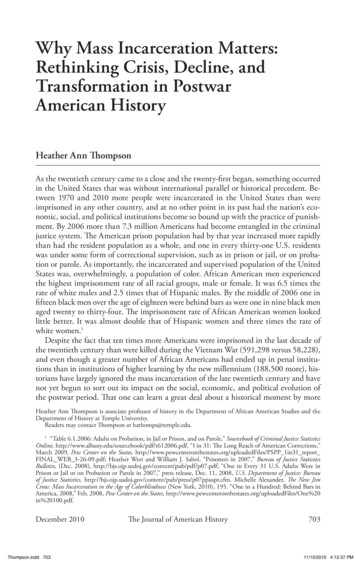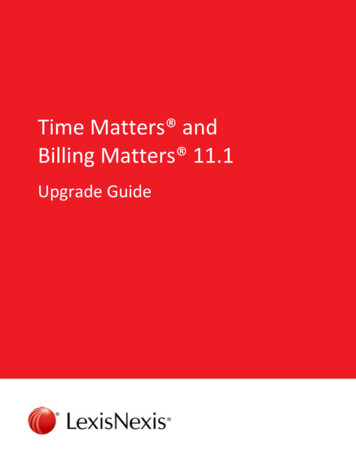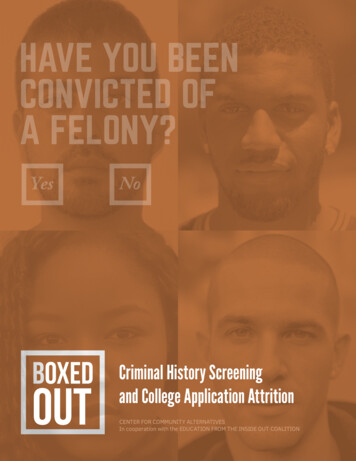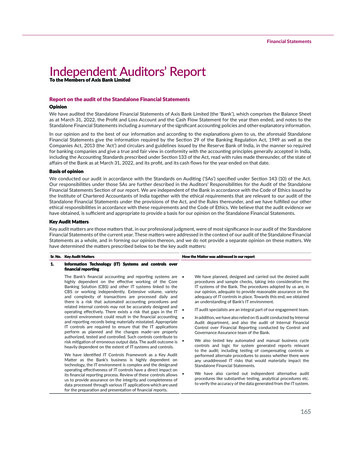
Transcription
Why Mass Incarceration Matters:Rethinking Crisis, Decline, andTransformation in PostwarAmerican HistoryHeather Ann ThompsonAs the twentieth century came to a close and the twenty-first began, something occurredin the United States that was without international parallel or historical precedent. Between 1970 and 2010 more people were incarcerated in the United States than wereimprisoned in any other country, and at no other point in its past had the nation’s economic, social, and political institutions become so bound up with the practice of punishment. By 2006 more than 7.3 million Americans had become entangled in the criminaljustice system. The American prison population had by that year increased more rapidlythan had the resident population as a whole, and one in every thirty-one U.S. residentswas under some form of correctional supervision, such as in prison or jail, or on probation or parole. As importantly, the incarcerated and supervised population of the UnitedStates was, overwhelmingly, a population of color. African American men experiencedthe highest imprisonment rate of all racial groups, male or female. It was 6.5 times therate of white males and 2.5 times that of Hispanic males. By the middle of 2006 one infifteen black men over the age of eighteen were behind bars as were one in nine black menaged twenty to thirty-four. The imprisonment rate of African American women lookedlittle better. It was almost double that of Hispanic women and three times the rate ofwhite women.1Despite the fact that ten times more Americans were imprisoned in the last decade ofthe twentieth century than were killed during the Vietnam War (591,298 versus 58,228),and even though a greater number of African Americans had ended up in penal institutions than in institutions of higher learning by the new millennium (188,500 more), historians have largely ignored the mass incarceration of the late twentieth century and havenot yet begun to sort out its impact on the social, economic, and political evolution ofthe postwar period. That one can learn a great deal about a historical moment by moreHeather Ann Thompson is associate professor of history in the Department of African American Studies and theDepartment of History at Temple University.Readers may contact Thompson at hathomps@temple.edu.1“Table 6.1.2006: Adults on Probation, in Jail or Prison, and on Parole,” Sourcebook of Criminal Justice StatisticsOnline, http://www.albany.edu/sourcebook/pdf/t612006.pdf. “1 in 31: The Long Reach of American Corrections,”March 2009, Pew Center on the States, PSPP 1in31 reportFINAL WEB 3-26-09.pdf; Heather West and William J. Sabol, “Prisoners in 2007,” Bureau of Justice StatisticsBulletin, (Dec. 2008), http://bjs.ojp.usdoj.gov/content/pub/pdf/p07.pdf; “One in Every 31 U.S. Adults Were inPrison or Jail or on Probation or Parole in 2007,” press release, Dec. 11, 2008, U.S. Department of Justice: Bureauof Justice Statistics, pr.cfm. Michelle Alexander, The New JimCrow: Mass Incarceration in the Age of Colorblindness (New York, 2010), 195. “One in a Hundred: Behind Bars inAmerica, 2008,” Feb. 2008, Pew Center on the States, One%20in%20100.pdf.December 2010Thompson.indd 703The Journal of American History70311/15/2010 4:12:37 PM
704The Journal of American HistoryDecember 2010closely examining the politics of crime and punishment is not news to historians of thenineteenth century, many of whom came to understand the post–Civil War South far better after fleshing out its criminal justice system.2 Thanks to several pathbreaking studies itbecame clear that southern whites responded to African American claims on freedom byredefining crime and imprisoning unprecedented numbers of black men. It was also evident that their response revealed as much about the triumphs of capitalism, the failuresof Radical Reconstruction, and the successful machinations of the southern Democraticparty as it did about actual crime or even punishment in this region.The way that Americans viewed and addressed crime was no less historically situatedand complex after the nineteenth century than it was during. Just as the American justice system changed dramatically in the wake of major historical revolutions such as theabolition of slavery, so too did it metamorphize much later in the twentieth century asthe nation was further contested and transformed. This was particularly the case following the 1960s, the decade of social activism and possibility that the historian ManningMarable has aptly termed the “Second Reconstruction.” In the thirty-five years leading upto and including the tumultuous 1960s, the number of Americans incarcerated in federaland state prisons had increased by 52,249 people. In the subsequent thirty-five years thatgroup increased by 1,266,2435. There is little question that such numbers both reflectedand shaped the history of postwar America.3It is not that historians of the twentieth-century United States have overlooked thenation’s criminal justice system entirely.4 A number of new works have, for example, fur2Edward L. Ayers, Vengeance and Justice: Crime and Punishment in the 19th-Century American South (NewYork, 1984); Mary Ellen Curtin, Black Prisoners and Their World, Alabama, 1865–1900 (Charlottesville, 2000);Alex Lichtenstein, Twice the Work of Free Labor: The Political Economy of Convict Labor in the New South (New York,1996); David M. Oshinsky, “Worse Than Slavery”: Parchman Farm and the Ordeal of Jim Crow Justice (New York,1997); Karin Shapiro, A New South Rebellion: The Battle against Convict Labor in the Tennessee Coalfields, 1871–1896 (Chapel Hill, 1998); Talitha L. LeFlouria, “Convict Women and Their Quest for Humanity: Examining Patterns of Race, Class, and Gender in Georgia’s Convict Lease and Chain Gang Systems, 1865–1917” (Ph.D. diss.,Howard University, 2009).3Manning Marable, Race, Reform, and Rebellion: The Second Reconstruction in Black America (1991; Jackson,2003), 3. “Table 6.13.2008.”4On the shifting ideas regarding crime and criminality in the North between 1900 and 1945, see Khalil GibranMuhammad, The Condemnation of Blackness: Race, Crime, and the Making of Modern Urban America (Cambridge,Mass., 2010); Jeffery Adler, First in Violence, Deepest in Dirt: Homicide in Chicago, 1875–1920 (Cambridge, Mass.,2006); Kali Gross, Colored Amazons: Crime, Violence, and Black Women in the City of Brotherly Love, 1880–1910(Durham, 2006); Cheryl Hicks, Talk with You like a Woman: African American Women, Justice, and Reform in NewYork, 1890–1935 (Chapel Hill, 2010); Rebecca M. McLennan, The Crisis of Imprisonment: Protest, Politics, and theMaking of the American Penal State, 1776–1941 (New York, 2008); and Lawrence M. Friedman, Crime and Punishment in American History (New York, 1993). On carceral institutions after 1945, see Donna Murch, Living forthe City: Migration, Education, and the Rise of the Black Panther Party in Oakland, California (Chapel Hill, 2010);Robert Chase, “Civil Rights on the Cell Block: Race, Reform, and Violence in Texas Prisons and the Nation, 1945–1990” (Ph.D. diss., University of Maryland, 2009); Norwood Henry Andrews III, “Sunbelt Justice: Politics, theProfessions, and the History of Sentencing and Corrections in Texas since 1968” (Ph.D. diss., University of Texas,Austin, 2007); Volker Janssen, “Convict Labor, Civic Welfare: Rehabilitation in California’s Prisons, 1941–1971”(Ph.D. diss., University of California, San Diego, 2005); Volker Janssen, “When the ‘Jungle’ Met the Forest: Public Work, Civil Defense, and Prison Camps in Postwar California,” Journal of American History, 96 (Dec. 2009),702–26; Heather McCarty, “From Con-Boss to Gang Lord: The Transformation of Social Relations in CaliforniaPrisons, 1943–1983” (Ph.D. diss., University of California, Berkeley, 2004); Staughton Lynd, Lucasville: The Untold Story of a Prison Uprising (Philadelphia, 2004); and Robert Perkinson, Texas Tough: The Rise of America’s PrisonEmpire (New York, 2010). For works by nonhistorians, see, for example, Mona Lynch, Sunbelt Justice: Arizona andthe Transformation of American Punishment (Stanford, 2009); Ruth Wilson Gilmore, Golden Gulag: Prisons, Surplus,Crisis, and Opposition in Globalizing California (Berkeley, 2007); Christian Parenti, Lockdown America: Police andPrisons in the Age of Crisis (New York, 2000); Marie Gottshaulk, The Prison and the Gallows: The Politics of MassIncarceration in America (New York, 2006); Jonathan Simon, Governing through Crime: How the War on CrimeTransformed American Democracy and Created a Culture of Fear (New York, 2009); Glenn C. Loury, ed., Race, Incar-Thompson.indd 70411/15/2010 4:12:37 PM
Mass Incarceration in Postwar American History705thered our understanding of crime and criminality and have called needed attention tothe fact that ideas about both shifted substantially in the North between 1900 and 1945.Historians have also recently written riveting narrative accounts of the ways carceral institutions operated during the second half of the twentieth century. Overwhelmingly,however, attempts to grapple with the broad impact of the postwar rise of the carceralstate have remained the preserve of journalists, legal scholars, criminologists, and othersocial scientists. It is time for historians to think critically about mass incarceration andbegin to consider the reverberations of this never-before-seen phenomenon.5 Not onlycan we revisit myriad archival collections to sort out what the rise of the carceral state really meant for postwar America, but we can also now draw from a wealth of data generated by the many governmental agencies that were connected to the justice system overthe last fifty years, as well as by an array of social scientists recently interested in criminaljustice issues.6 Investigative journalists can similarly provide invaluable information aboutthe ways people and places were affected by the rise of a more punitive and far-reachingcriminal justice system. Drawing from such a rich pool of traditional archival as well asnonarchival materials and examining for the first time the broad impact of mass incarceration gives historians an opportunity to reassess much that has been written about thetumultuous evolution of the postwar period.This essay will suggest, for example, that to understand why so many prosperousAmerican cities became centers of poverty and pessimism during the postwar period—tofully locate the origins of urban crisis—we must reckon with the extent to which postwarurban spaces were compromised by the mass incarceration of the later twentieth century.Likewise, to make sense of why the American labor movement declined so dramaticallyafter the 1970s, we must explore the significant changes to the law and the economy thataccompanied mass incarceration—changes that directly and indirectly eroded the bargaining power and economic security of America’s free-world work force. And finally,if we hope to sort out why the politics of postwar liberalism waned over this period, wemust realize that the nation’s rightward shift had more to do with mass incarceration thanwe have yet appreciated and less to do with rising crime rates and the political savvy of theRepublican party than we have long assumed.ceration, and American Values (Cambridge, Mass., 2008); Mary Louise Frampton, Ian Haney López, and JonathanSimon, eds., After the War on Crime: Race, Democracy, and a New Reconstruction (New York, 2008); David Garland,The Culture of Control: Crime and Social Order in Contemporary Society (Chicago, 2002); Bruce Western, Punishmentand Inequality in America (New York, 2007); Todd Clear, Imprisoning Communities: How Mass Incarceration MakesDisadvantaged Neighborhoods Worse (New York, 2009); Loïc Wacquant, Prisons of Poverty (Minneapolis, 2009); andVesla Weaver, “Frontlash: Race and the Development of Punitive Crime Policy,” Studies in American Political Development, 21 (Fall 2007), 230–65.5“Table 6.13.2008: Number and Rate (per 100,000 U.S. Residents) of Persons in State and Federal Prisonsand Local Jails,” Sourcebook of Criminal Justice Statistics Online, http://www.albany.edu/sourcebook/pdf/t6132008.pdf; “Vietnam Conflict: Casualty Summary,” table, in “American War and Military Operations Casualties,” byAnne Leland and Mari-Jana Oboroceanu, Congressional Research Services report, Feb. 26, 2010, Federation ofAmerican Scientists, http://www.fas.org/sgp/crs/natsec/RL32492.pdf, p. 11; “Statistical Information about Casualties of the Vietnam War: Electronic and Special Media Records Services Division Reference Report,” rg 330,National Archives, lty-statistics.html#branch; “Table 195: Enrollment Rates of 18- to 24-Year-Olds in Degree-Granting Institutions, by Sex and Race/Ethnicity, 1967 through2006,” National Center for Education Statistics, http://nces.ed.gov/programs/digest/d07/tables/dt07 195.asp. “Cellblocks or Classrooms? The Funding of Higher Education and Corrections and Its Impact on African AmericanMen,” Sept. 18, 2002, Justice Policy Institute, http://www.justicepolicy.org/images/upload/02-09 REP CellblocksClassrooms BB-AC.pdf.6As Khalil Muhammad’s recent work on crime in the Progressive Era makes clear, scholars must take care whenusing social science data related to the justice system and always bear in mind the historical context in which socialscientists collected and interpreted their data. See Muhammad, Condemnation of Blackness, 283–84.Thompson.indd 70511/15/2010 4:12:37 PM
706The Journal of American HistoryDecember 2010Mass Incarceration and the Origins of Urban CrisisHistoricizing mass incarceration can provide new perspectives on many of the questionsthat historians ask about the postwar period. One of the most central of these concernswhy America’s inner cities came to suffer such crisis toward the end of the twentiethcentury. Right after World War II cities were, at least in the popular and commercialimagination, the lifeblood of the nation. A mere four decades later, however, few wouldhave subscribed to that view. As the postwar period unfolded not only did numerousurban centers across the country suffer deep racial and political conflicts but these samecities also experienced tremendous distress from substantial economic disinvestment. Bythe twenty-first century too many urban enclaves had become synonymous with unrelenting and seemingly inescapable poverty. Eulogizing three of America’s largest cities,Los Angeles, New York, and Washington, D.C., one scholar wrote, “The future oncehappened here.”7Historians have not just lamented the death of inner-city America, they have also donea great deal of important work on the origins of its demise. Thomas Sugrue’s pivotal studyof Detroit, for example, highlights the role that deindustrialization and white racial conservatism played in creating a crisis from which the city simply could not escape. Others, such as Matthew Lassiter, have pointed to the ways that mass suburbanization in themiddle and later decades of the twentieth century also undermined urban America.8 All ofthese phenomena clearly mattered, but so did the postwar expansion of the carceral stateand its eventual byproduct, mass incarceration.The dramatic postwar rise of the carceral state depended directly on what might wellbe called the “criminalization of urban space,” a process by which increasing numbers ofurban dwellers—overwhelmingly men and women of color—became subject to a growing number of laws that not only regulated bodies and communities in thoroughly newways but also subjected violators to unprecedented time behind bars. In the same waythat rural African American spaces were criminalized at the end of the Civil War, resultingin the record imprisonment of black men that undermined African American communities in the Reconstruction and Jim Crow–era South, the criminalization of urban spacesof color, in both the South and North, during and after the 1960s civil rights era fundamentally altered the social and economic landscape of the late twentieth- and earlytwenty-first-century United States.97Although the stability of urban centers was actually tenuous in the 1950s, most inner cities were more populous and vibrant than they would be later. On city centers earlier on, see Alison Isenburg, Downtown America: AHistory of the Place and the People Who Made It (Chicago, 2005). Fred Siegel, The Future Once Happened Here: NewYork, D.C., L.A., and the Fate of America’s Big Cities (New York, 2000).8Thomas J. Sugrue, The Origins of the Urban Crisis: Race and Inequality in Postwar Detroit (Princeton, 1996);Matthew Lassiter, The Silent Majority: Suburban Politics in the Sunbelt South (Princeton, 2005); Arnold Hirsch,Making the Second Ghetto: Race and Housing in Chicago, 1940–1960 (Chicago, 1998); Wendell Pritchett, Brownsville, Brooklyn: Blacks, Jews, and the Changing Face of the Ghetto (Chicago, 2002); Amanda Seligman, Block by Block:Neighborhoods and Public Policy on Chicago’s West Side (Chicago, 2005); Robert O. Self, American Babylon: Race andthe Struggle for Postwar Oakland (Princeton, 2004); Kenneth Jackson, Crabgrass Frontier: The Suburbanization of theUnited States (New York, 1987); Jane Jacobs, The Death and Life of Great American Cities (1961; New York, 1992);Kevin M. Kruse and Thomas J. Sugrue, eds., The New Suburban History (Chicago, 2006); Kevin M. Kruse, WhiteFlight: Atlanta and the Making of Modern Conservatism (Princeton, 2005); David M. P. Freund, Colored Property:State Policy and White Racial Politics in Suburban America (Chicago, 2008).9The term “criminalization of urban space” is my own, but my attention was called to this phenomenon byClear, Imprisoning Communities. Loïc Wacquant, “Racial Stigma in the Making of the Punitive State,” in Race, Incarceration, and American Values, ed. Loury, 57–70.Thompson.indd 70611/15/2010 4:12:37 PM
Mass Incarceration in Postwar American History707As Khalil Muhammad and Donna Murch have both pointed out, the focus of law enforcement on urban African Americans, which became a hallmark of the last third of thetwentieth century, was rooted in much earlier decades. As Muhammad shows, northernsocial scientists throughout the Progressive Era were using census data to try to “prove”that blacks were inherently prone to criminality, and thus needed greater police scrutiny. He notes as well that such associations between blackness and crime only deepenedas the twentieth century unfolded. One of the most important privileges that workingclass whites gained as a result of being courted by, and included in, the New Deal liberalstate, he argues, was a new claim on citizenship that finally rid them of many negative assumptions about their class position and thus tended to inoculate them from associationwith criminality. African Americans, who had been shut out of the New Deal’s largesse,however, were afforded neither equal citizenship nor the privilege of presumed honestythat came with it. In stark contrast to white working-class Americans, who increasinglyclaimed the mantle of crime victim over the course of the twentieth century, poor blackswere increasingly blamed for any crime problem America had. As Murch also shows clearly, by the first decades of the postwar period, much of white America had come to see thepresence of African Americans, and their concentration in inner cities in particular, as inherently threatening and it advocated policing them accordingly.10By the late 1960s, however, with African Americans across the country actively layingclaim to equal citizenship, the urban spaces in which they lived were soon criminalized toan unprecedented extent. One of the most important mechanisms by which urban spaceswere newly criminalized after the civil rights sixties was a revolution in drug legislation.The state of New York started this revolution by passing a series of new drug laws in 1973.These laws were somewhat ironically named after the then-governor Nelson Rockefeller,who had actually long favored a rehabilitative approach to his state’s drug problem. In1971, however, Rockefeller faced a major civil rights challenge to this authority—onethat fundamentally changed his outlook on those who had committed and led him toembrace more punitive measures for dealing with all lawbreakers, including those whoused and sold illegal drugs.11By the end of the 1960s Rockefeller had already witnessed countless grassroots protestsin his state and, when a massive rebellion of over twelve hundred mostly African American inmates began at New York’s Attica State Correctional Facility in the fall of 1971, hedecided that the time had come to take a hard line and rethink how he had been handling10Muhammad, Condemnation of Blackness, 12–13, 270, 272, 275; Khalil Gibran Muhammad, “Where Did Allof the White Criminals Go? The Remapping of Racial Criminalities on the Road to Mass Incarceration,” paper delivered at the “Historians and the Carceral State: Writing Policing and Punishment into Modern U.S. History” symposium, Rutgers University, March 5, 2009 (in Heather Ann Thompson’s possession), 3. Murch, Living for the City.11Rhonda Y. Williams, “The Dope Wars: Street-Level Hustling and the Culture of Drugs in Post-1940s America,” unpublished manuscript (in Rhonda Y. Williams’s possession). According to Julilly Kohler-Hausmann, although Nelson Rockefeller first “positioned the addict as a victim of disease and allowed criminal offenders to optfor lengthy treatment programs instead of incarceration,” by 1973 he was proposing “that the state make the penaltyfor sale of hard drugs, regardless of quantity, a lifetime in prison without any option of plea-bargaining, probation,or parole.” Julilly Kohler-Hausmann, “‘The Attila the Hun Law’: New York’s Rockefeller Drug Laws and the Making of the Punitive State,” Journal of Social History, 44 (Fall 2010), 76. The sociologist Vanessa Barker has arguedthat Rockefeller turned to more stringent drug legislation only reluctantly and did so “in frustration rather than asa primary or automatic response to crime.” Vanessa Barker, The Politics of Imprisonment: How the Democratic Process Shapes the Way America Punishes Offenders (New York, 2009), 149. Others discount the immediate impact ofthe Rockefeller drug laws—arguing that rising incarceration rates were due less to the law than to later “legislativechanges that expanded its scope.” See David F. Weiman and Christopher Weiss, “The Origins of Mass Incarcerationin New York State: The Rockefeller Drug Laws and the Local War on Drugs,” in Do Prisons Make Us Safer? The Benefits and Costs of the Prison Boom, ed. Steven Raphael and Michael A. Stoll (New York, 2009), 89.Thompson.indd 70711/15/2010 4:12:37 PM
708The Journal of American HistoryDecember 2010New York City’s “fringe elements”—whether inmates, activists, or addicts. Determinedto show conservatives in his party that he was tough on crime, Rockefeller not only choseto put down the Attica rebellion with deadly force but he publicly committed himself tocertain “enduring principles” such as society’s need for law and order. According to Rockefeller there was a clear “moral responsibility confronting a leader in moments of crisis”:to uphold the law and make it clear that those who committed crimes in his state wouldnot be coddled. As the Rockefeller staffer Joe Persico put it in a speech he drafted for thegovernor mere days after the retaking of Attica, “Once the orderly structure of society isbreached, where does it end?”12As a result of the decision in New York to draw a line in the sand vis-à-vis drugs in themid-1970s, the state’s prison population soared. By the 1990s, 32.2 percent of inmatesin New York’s prisons were locked up for drug offenses, and significantly, the majority ofthem hailed from the state’s most urban enclaves. In fact, New York’s urban spaces were soimpacted by drug legislation in the last decades of the twentieth century that by the newmillennium 66 percent of the prisoners who filled the state’s vast prison system had beenarrested in, and were from, New York City.13By the close of the twentieth century, New York–style drug laws had been implemented across the nation, and the incarceration rate of inner-city dwellers everywhere escalateddramatically. While in 1970 there had been only 322,300 drug-related arrests in the United States, in 2000 that figure was 1,375,600, and again, the majority of those taken intocustody came from inner cities. There were eventually more Detroiters under correctionalsupervision than there were holding union jobs in the city’s auto plants.14Law enforcement not only disproportionately targeted cities in its new war on drugsbut it also particularly policed the communities of color within them; this, despite extensive and readily available data that these areas were not where most drug trafficking andusage took place. As studies done by the National Institute on Drug Abuse and the National Household Survey on Drug Abuse noted in 2000, not only did “white students usecocaine at seven times the rate of black students, use crack cocaine at eight times the rateof black students, and use heroin at seven times the rate of black students,” but whites12Rockefeller believed that the roots of the riot at the Attica State Correctional Facility lay not in legitimateinmate grievances but rather in “the well-organized national effort of revolutionaries.” As a result of the forcibleretaking of Attica thirty-nine people (both hostages and inmates) were shot to death and hundreds of others wereseverely wounded. See draft of Nelson Rockefeller speech to be given at the New York State Bar Association, Sept.24, 1971, folder 3471, box 85, series 33: speeches, record group 15: gubernatorial, Nelson Aldrich Rockefeller Papers (Rockefeller Archive Center, Sleepy Hollow, N.Y.). Joe Persico to the Governor [Nelson Rockefeller], memoon the dedication of new State Bar Association building, Sept. 22, 1971, folder 3466, box 85, series 33: speeches,record group 15: gubernatorial, Rockefeller Papers. For more on the Attica rebellion, see Heather Ann Thompson,“Blinded by a ‘Barbaric’ South: Prison Horrors, Inmate Abuse, and the Ironic History of American Penal Reform,”in The Myth of Southern Exceptionalism, ed. Matthew D. Lassiter and Joseph Crespino (New York, 2009), 74–97;and Heather Ann Thompson, “All across the Nation: Urban Black Activism, North and South, 1965–1975,” inAfrican American Urban History since World War II, ed. Kenneth L. Kusmer and Joe W. Trotter (Chicago, 2009),181–202. Heather Ann Thompson is also completing a comprehensive history of the Attica uprising and its legacy,under contract with Pantheon Books.13Aaron D. Wilson, “Rockefeller Drug Laws Information Sheet,” prdi: Partnership for Responsible Drug Information, http://www.prdi.org/rocklawfact.html. “Before the New York State Legislative Task Force on DemographicResearch and Reapportionment: Testimony of Peter Wagner, March 14, 2002,” Prison Policy Initiative, http://www.prisonpolicy.org/articles/ny legis031402.pdf.14Tina L. Dorsey and Priscilla Middleton, “Drug and Crime Facts,” 2007, U.S. Department of Justice: Bureauof Justice Statistics, http://bjs.ojp.usdoj.gov/content/pub/pdf/dcf.pdf. By 2010 there were only 14,958 active UnitedAuto Workers members living in Detroit, and in 2007 there were already 24,272 Detroiters under some form ofcorrectional supervision with that number growing each year. Linda Ewing, United Auto Workers Union, telephoneconversation with Heather Ann Thompson, July 19, 2010, notes (in Thompson’s possession). “1 in 31,” 9.Thompson.indd 70811/15/2010 4:12:37 PM
Mass Incarceration in Postwar American History709U.S. Adult Drug-Related Arrests: 1970, 2000Adult Drug-Related CE: “Drugs and Crime Facts,” Bureau of Justice Statistics Report. NCJ 165148, pp. 61–62. U.S.Department of Justice. Office of Justice Programs. Washington, D.C., etween the ages of twelve and seventeen were also “more than a third more likely to havesold illegal drugs than African American youth.”15 In the 1980s alone, however, AfricanAmericans’ “share” of drug crimes jumped from 26.9 percent to 46.0 percent, and arrested black juveniles “were 37 percent more likely to be transferred to adult courts, wherethey faced tougher sanctions.” If convicted, African Americans of every age “were morelikely than whites to be committed to prison instead of jail, and they were more likely toreceive longer sentences.”16As much as criminalizing drugs impacted urban America in general, and poor neighborhoods of color in particular, both spaces were also disproportionately affected after1970 by an overhaul of state and federal sentencing guidelines related to drug convictions. Notably, the nation’s drug laws were “not passed in isolation”: one of the first majorbills calling for mandatory minimum sentences at the federal level was introduced in theU.S. Senate in 1976, followed by similar bills at the state level. Over the next twenty-fiveyears prison terms across the country lengthened substantially. Between the 1980s andthe 1990s “the chances of receiving a prison sentence following arrest increased by morethan 50 percent” and “the average length of sentences served increas[ed] by nearly 40percent.”17Alexander, New Jim Crow, 97; Weiman and Weiss, “Origins of Mass Incarceration in New York State,” 81.Weiman and Weiss, “Origins of Mass Incarceration in New York State,” 81, 84.17William J. Sabol et al., “The Influences of Truth-in-Sentencing Reforms on Changes in States’ Sentencing Practices and Prison Populations,” April 1, 2002, Urban Institute, http://www.urban.org/publicat
FINAL_WEB_3-26-09.pdf; Heather West and William J. Sabol, “Prisoners in 2007,” Bureau of Justice Statistics Bulletin, . Michelle Alexander, The New Jim Crow: Mass Incarceration in the Age of Colorblindness (New










